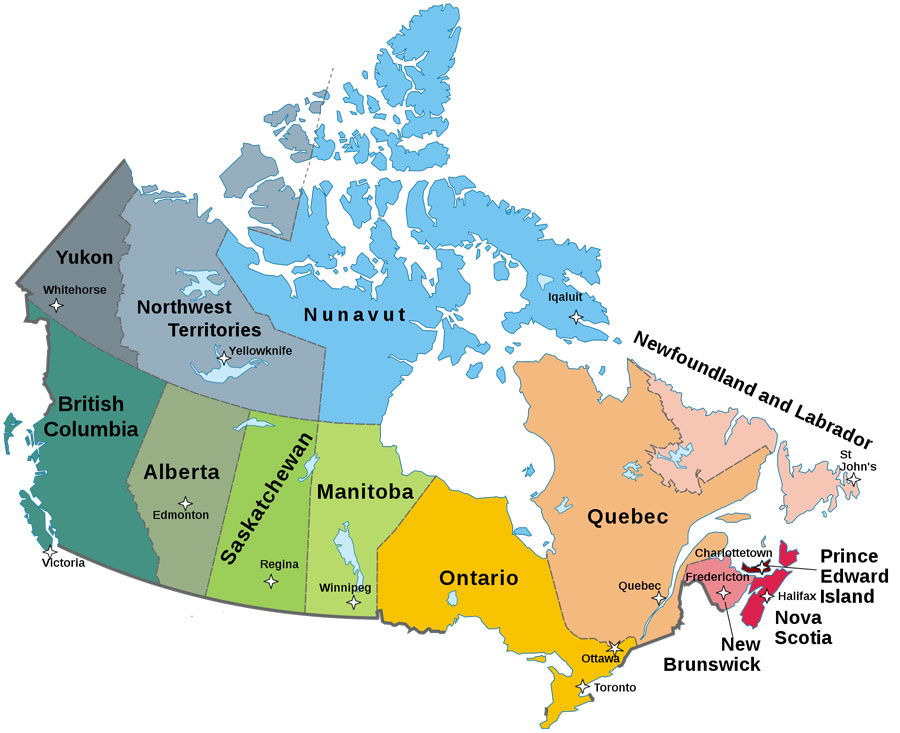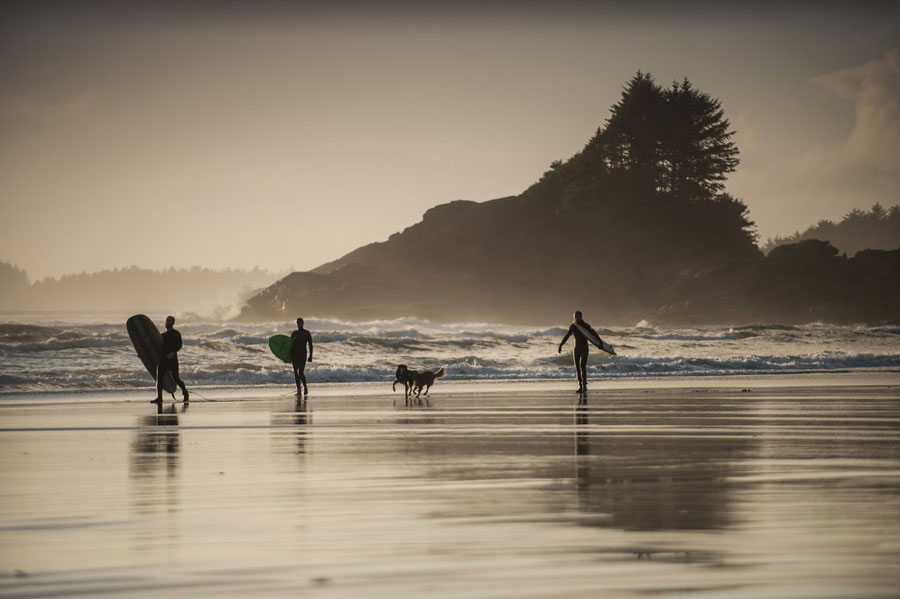B3. Geography, Regions, and Climate
Occupying the northern region of the North American continent, Canada’s land mass is 9,093,507 square kilometres, making it the second largest country in the world after Russia. In addition to coastlines on the Atlantic and Pacific oceans, Canada has a third seacoast on the Arctic Ocean, giving it the longest coastline of any country. To the south, Canada shares an 8,893-kilometre land border—the longest in the world—with the United States. To the north, the Arctic islands come within 800 kilometres of the North Pole. Canada’s neighbour across the Arctic Ocean is Russia.

Among Canada’s most distinctive features are the vast mountain ranges: the Torngats, Appalachians and Laurentians in the east, the Rocky, Coastal, and Mackenzie ranges in the west, and Mount St. Elias and the Pelly Mountains in the north.
There are more than two million lakes in Canada covering about 7.6 percent of the country. The main lakes are Huron, Superior, Erie, and Ontario (known as the Great Lakes) as well as Great Bear, Great Slave, and Winnipeg. The St. Lawrence River (3,058 km long) is Canada’s most important river, providing a seaway for ships from the Great Lakes to the Atlantic Ocean. In total, Canada has almost 900,000 km2 of fresh water.
There are ten provinces and three territories in Canada spanning a few geographic regions. These are detailed in brief below. Further details on each province can be found on the “Where To Go” section of the Destination Canada website. Agents should direct students wanting to learn about Canada to this website, and use it to familiarize themselves with the different parts of Canada.
Atlantic Canada: This region includes the provinces of Prince Edward Island, New Brunswick, Newfoundland and Labrador, and Nova Scotia. In these picturesque and charming provinces, you’ll find some of the most unique and friendly people in the world. The music, folklore, seafood, and scenery in Atlantic Canada are unlike anywhere else. The region boasts countless beaches, coves, parks, and forests, and the towns and cities are often quaint and filled with Maritime artifacts. Tiny villages abound, but there are also cities like Charlottetown, Fredericton, Halifax and St. John’s.
Central Canada: Quebec and Ontario are the provinces of Central Canada, and the large cities of Toronto, Ottawa (Canada’s capital city), Montreal, and Quebec City are found in this region. Excellent cuisine is to be found in these cosmopolitan centres, but also in the smaller villages and towns, where fresh, local ingredients are proudly featured. There are famous wine-growing regions, the largest skating rink in the world (the Rideau Canal), Parliament Hill, dense forests, and excellent lakeside camping grounds. Central Canada is a perfect mix of urban delights and outdoorsy adventure.
The Prairies: In the prairie provinces of Saskatchewan and Manitoba one can find some of the most extraordinary natural beauty in Canada—from seemingly endless fields of wheat in the summer to almost Arctic conditions in the winter. This region is made for those who love hiking, boating, skiing, or fishing—and lots of space. At the same time, the cities and towns of Saskatchewan and Manitoba are incredibly diverse, friendly, and interesting—boasting a wonderful mix of immigrant cultures, cuisines, and celebrations.
The West: Like Central Canada, the western provinces of British Columbia and Alberta feature an extraordinary mix of nature and ultra-urban delights. But the nature is on a different scale— bigger, taller, and more open. Think mountains, ocean (British Columbia), wineries, golf, whale watching, stunning gardens, and the mildest climate in Canada. World-renowned ski resorts Whistler and Banff are in this region, as are the famous Rocky Mountains. British Columbia’s city of Vancouver is one of the world’s most beautiful with an eclectic mix of ethnicities and influences, many from Asia. Calgary, in Alberta, is one of the fastest-growing cities in Canada, and headquarters to many oil and gas companies.
The North: Canada’s North—encompassing the Yukon, Northwest Territories and Nunavut—is one of the most striking examples of pristine wilderness left in the world. Arctic creatures include polar bears, walruses, seals, white wolves, snowy owls, and caribou. Yet, while this region draws rugged adventurers and thrill-seeking tourists, it also contains interesting, vibrant cities (Yellowknife, Whitehorse, Iqaluit) and amazing arts festivals featuring Inuit art and culture as well as those from more recent arrivals in the region.
Climate
About 80% of Canadians live within 160 kilometres of the country’s southern border, where there are warm springs, hot summers, and pleasantly crisp autumns. Winter usually runs from December to March, but the exact dates and lowest temperatures will vary across the country. Canada’s climate is characterized by its diversity, both from region to region and with four distinct seasons.

Canada’s seasonal temperature variations are embraced by Canadians: there are so many leisure activities to choose from as a result, from swimming outdoors in the summer to skiing in the winter! Although many outdoor activities require special equipment, rentals or second-hand items are easy to find and affordable. Most institutions have clubs which will bring student groups camping or skiing, making outdoor activities even more accessible to international students.

International students should be assured that all buildings in which they will study are well-heated in winter months, and most have air conditioning in the summer. Many university and college campuses have underground tunnels or covered bridges through which students can move from building to building in comfort, regardless of the weather.
Temperatures vary through the year and depending on the city. For example, students staying for a year in Toronto may see +35C as well as -20C, while students studying in Vancouver or Halifax will see more mild temperatures but will have many more rainy days. Agents should advise students studying in Canada to bring appropriate clothing depending on the weather conditions they are likely to face, for example a warm coat, hat, boots, scarf and mittens in the winter, a good rain coat for spring and summer, and cool summer clothing for those staying in June – August. For more detailed weather information visit: https://weather.gc.ca.
